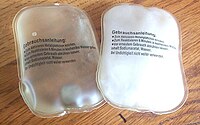
Photo from wikipedia
For the development of advanced flexible and wearable electronic devices, functional electrolytes with excellent conductivity, temperature tolerance, and desirable mechanical properties need to be engineered. Herein, an alkaline double-network hydrogel… Click to show full abstract
For the development of advanced flexible and wearable electronic devices, functional electrolytes with excellent conductivity, temperature tolerance, and desirable mechanical properties need to be engineered. Herein, an alkaline double-network hydrogel with high conductivity, superior mechanical and anti-freezing properties is designed, and promisingly utilized as the flexible electrolyte in all-solid-state zinc-air batteries. The conductive hydrogel is comprised of covalently crosslinked polyelectrolyte poly(2-acrylamido-2-methylpropanesulfonic acid potassium salt) (PAMPS-K) and interpenetrating methyl cellulose (MC) in the presence of concentrated alkaline solutions. The covalently crosslinked PAMPS-K skeleton and interpenetrating MC chains endow the hydrogel with good mechanical strength, toughness, extremely rapid self-recovery capability, and outstanding anti-fatigue property. Gratifyingly, the entrapment of concentrated alkaline solution into the hydrogel matrix achieves extremely high ionic conductivity (up to 105 mS·cm-1 at 25 °C) and excellent anti-freezing capacity. The hydrogel retains comparable conductivity and eligible strength to withstand various mechanical deformations at -20 °C. The all-solid-state zinc-air batteries using PAMPS-K/MC hydrogels as flexible alkaline electrolytes exhibit comparable specific capacity (764.7 mAh·g-1), energy capacity (850.2 mWh·g-1), cycling stability and mechanical flexibility. The batteries still possess competitive electrochemical performances even the operating temperature drops to -20 °C.
Journal Title: ACS applied materials & interfaces
Year Published: 2020
Link to full text (if available)
Share on Social Media: Sign Up to like & get
recommendations!